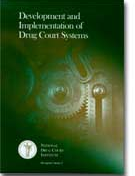April 30, 2012
Court Monitoring of Sentence Tracks: Part 5
Courts can deal effectively with all their sentenced felons, by developing comprehensive “evidence-based sentencing systems” (see Arming the Courts with Research: , Roger Warren, Pew, 2009). Traditionally, we classify, categorize, and sort felons into appropriate groupings at every step of sentencing process.The Sheriff decides an inmate’s housing category. The probation departments recommends whether a probationer should be intensively monitored or placed in a banked case load. The court determines whether a felon is to be placed on probation or sent to prison.(Click on image to the left for Development and Implementation of Drug Court Systems,JTauber,NDCI,1999)
Today’s problem-solving courts have led the way in in the use of assessments (and other evidence based sentencing practices) to improve our sorting or categorizing and thereby our sentencing outcomes. The court and its systemic partners determine if an offender needs special rehabilitation, treamtment, or education as part of the sentencing process. So a DUI offender with a third offense might require a residential alcohol treatment program, the domestic violence offender, an extensive series of violence reduction classes, and the drug offender, completion of a appropriate drug treatment program. In each instance, the court will continue to monitor the offenders at progress report hearings until the relevant conditions of probation are completed.
To optimize the effectiveness of a sentencing court’s monitoring of all felony sentences (see: Systemic Approaches to Sentencing: Part 3), we now use a more comprehensive process, a validated risk/needs assesssment, to sort the offenders into appropriate tracks. A felon is determined to be a low, medium, or high risk offender. Depending on that determination, an individual is placed in different probation, treatment or rehabilitation tracks, with the court actively monitoring those tracks on an regular schedule over the term of probation (and in some cases parole). In effect, a “special sentencing team”, led by the sentencing judge, follows all offenders placed in sentencing tracks, as they move seamlessly through sentencing and custody (where ordered) and into the probation process.
It should be remembered, that though all felons are categirized and placed in tracks, that very process is intended to increase the court’s effectiveness, by limiting the court’s contact with the low risk/low needs offenders. If the sentencing court is to effectively deal with all felons, it will need to distinguish between those who require the court’s attention and those that are best left alone. Substantial savings in time, staffing, and resources lie in the court’s effective and appropriate tracking of sentenced offenders.
The next segment will look at how sentencing tracks work in a systemic sentencing court.


